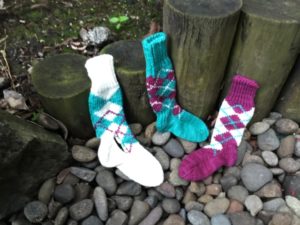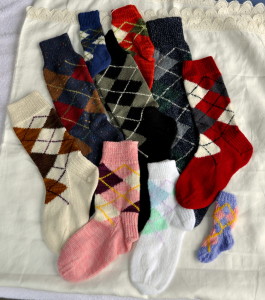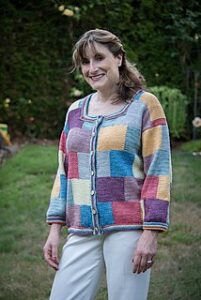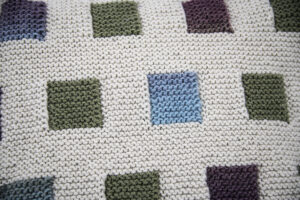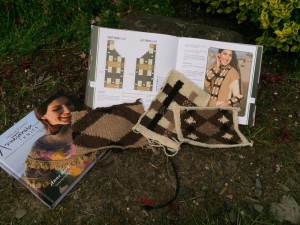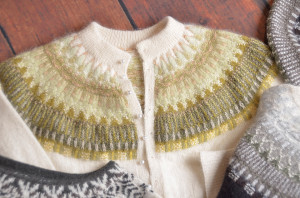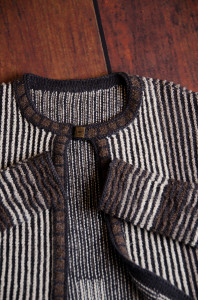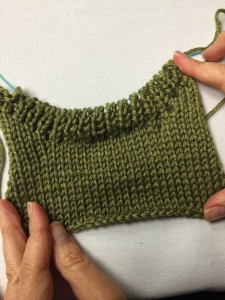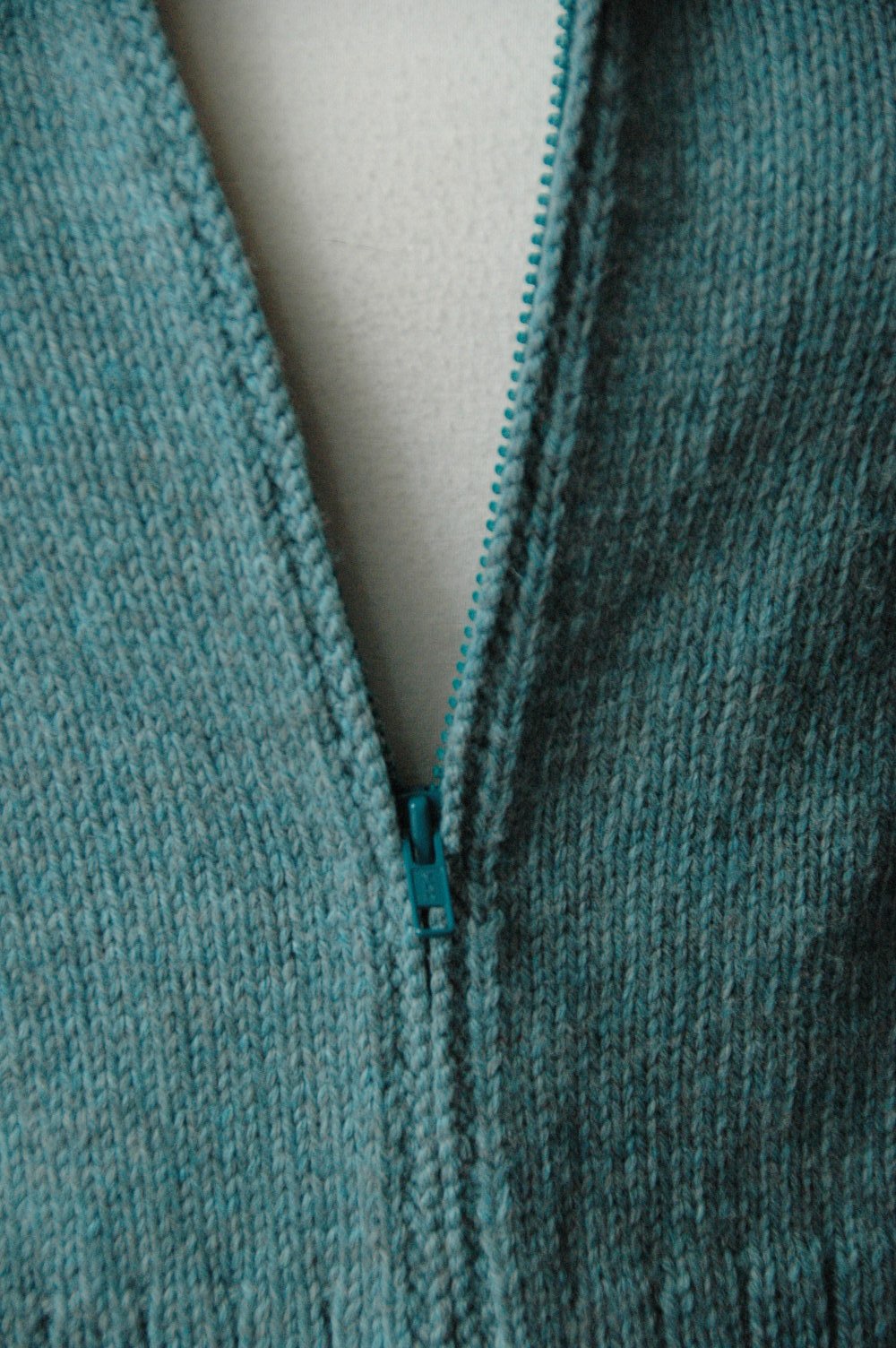
Anne wearing the Cotton version of Gramercy Park to the office.
“Annetarsia Knits” is still available, from me. It was designed for people to learn from the book, and people tell me that when they read it, they hear my voice! So, it is a very good option. Check the Book page to order an autographed copy of the hardback, and you can get the PDF version also, if you like that option.
However, I am happy to teach on-line or in-person, if you wish more personalized instruction. Here is my information and a class list.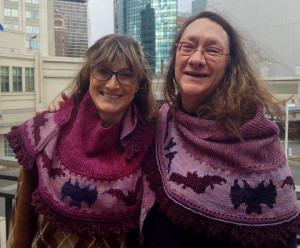
Anne Berk was certified by TKGA as a Master Knitter in 2003. Anne has designed for many yarn companies, published DVDs on intarsia technique with Interweave, and she has 3 classes on Craftsy, teaching various colorwork techniques. She has written patterns and articles for many publications, and designs can be found in her Ravelry store. She teaches classes nationally for events, Knitting Guilds and Yarn stores on subjects ranging from Argyle socks to Zipper insertion into hand-knits.
“Annetarsia Knits” is a reference book for learning to knit intarsia flat or in the round, in stockinette or garter stitch. The book includes workshops, a motif library, and 28 patterns for using the techniques. Content is designed for knitters of all skill levels. www.annetarsia.com/book Code: TEAMANNETARSIA for Free Shipping
Anne is also an optometrist in private practice in Happy Valley, Oregon. Contact Anne at www.annetarsia.com or at annetarsia@gmail.com.
_____________________________________________________________________________________________________________
Class list for Virtual and in-person learning
Argyle Socks
Class Length: 2 sessions, 2-3 H each, depending on student numbers
Skill: All Levels
Prerequisites: Knit, purl, and follow charted designs. Experience with the intarsia technique will be helpful, but not required.
Argyle socks are associated with the Scottish culture since 1500, but they took America by storm post-WWII. Popularity waxes and wanes, but this traditional patterning never goes out of style. Modern yarns and knitting needles are taking the argyle into the 21st century, and this is a great use for those Mini-skeins you are accumulating! Argyles are also an ideal medium for practicing intarsia technique. This class focuses on the traditional knitting method of knitting intarsia, worked flat during all intarsia portions. Have you ever knit a sock flat, before? It’s fun! You will learn the Mattress stitch, which creates an invisible seam from the RS, and it is very smooth on the WS. Knitting magic, at its finest.

Students Should Bring:
Yarn: Smooth sock yarns in 3 or more solid colors. I recommend as much contrast between colors as possible and yarns of equal weight. It is easier to see your joins and the development of the pattern if there is a big contrast of color at the join. So choose a light color to be next to a dark color, etc. You will be making the socks in the above photo, which are half adult size.
Knitting needles: dpn’s, straights and/or circular needles in sizes appropriate for your yarn. You will be knitting both flat and circularly. Straight needles are highly recommended for the flat sections, as they will help keep the yarn supplies separated from each other, but circular needles will be fine.
Notions: scissors, post-it notes or highlighter tape for following charts
Homework:
Using yarn that you will use as Main Color for your argyle practice sock,
Ribbed border: Cast on 34 sts. Work K1, P1 ribbing for about 1 “. 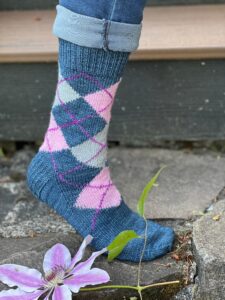



Students Should Bring: Smooth, worsted weight yarn in 3 or more contrasting colors, and appropriate sized needles (size 7-9 US). We will be knitting flat, and long dpn’s or straight needles are recommended, if available, to help keep the yarn supplies separated from each other. The class project is the argyle bag on the top left. The top middle bag is the same bag, felted.
Homework: None
Annetarsia: Intarsia “in the round” (ITR)
Class Length: 2-3 hours, depending on student numbers
Skill: Intermediate
Prerequisites: Knit, purl. Some experience with traditional intarsia and working from charts will be helpful, but not required.
Learning to do the “impossible” is fun! Like all magic, it is tricky, but easy once you know the secret and put it into practice. Knit intarsia in the round (ITR), with no visible seam, being able to knit motifs, pictures and messages on hats, socks, and sweaters with smooth, single-layer fabric. Explore techniques to manage yarn supplies, bury ends, and read the charts.
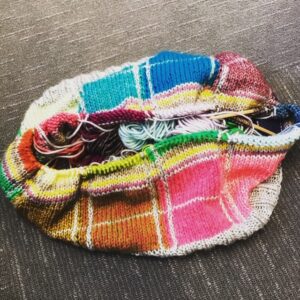

Students Should Bring:
Smooth, worsted weight yarn in at least 3 contrasting colors, and appropriate sized needles (7-9 US, circular needles 16” length). Yarn needles, scissors.
Homework:
Using any method, cast on 66 sts with one color onto a 16”circ needle. Being careful not to twist sts, join to work in the round. Work in k1, p1 ribbing for ½ to 1” deep (this is the edging for a small bag)
Annetarsia: Intarsia Garter Stitch
Class Length: 2 sessions, 2-3 H each, depending on student numbers
Skill: Intermediate
Prerequisites: Knit. Some experience with working from charts will be helpful, but not required
Intarsia allows knitters to paint pictures on their knitting and control color, while making a single layer fabric. Have you ever wondered why intarsia is always done in stockinette? Learn to break that rule, so that the benefits of garter stitch (reversible fabric that does not curl, and row gauge that equals stitch gauge) can be translated to your intarsia designs. The class sample is this pattern, the Dizzy Scarf.


Students Should Bring:
Smooth, worsted weight yarn in at least 3 contrasting colors, and appropriate sized needles (suggest size 7-8 US) We will be knitting flat, so long dpn’s or straight needles are recommended, if available. Class project will be suitable to knit the Dizzy Scarf, if you wish to keep knitting (small amounts of stash that total about 400 yds will be ideal )
Homework: none
Swatch n’ Block Party
Class Length: 2 H
Skill: All Levels
Prerequisites: none
Blocking and care of handknits is key to maintaining their appearance, fit and lifespan. Swatches are an important part of gaining control over the end result of your knitting. Learn how to create quick and efficient blocked swatches! Topics to be discussed include space considerations, the effect of water and soap on fiber, how to work around interested children and pets, and methods to store hand-knits after blocking to preserve their beauty.



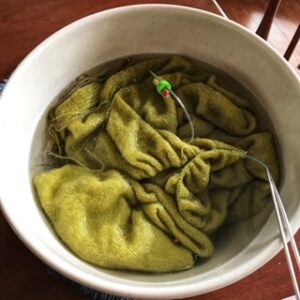
 Students Should Bring: Yarn for swatching at least 2 swatches, and assorted knitting needles and pattern(s) that seem appropriate for the yarn. A few kitchen towels, pins, measuring tools for checking gauge, rinse-free soap (Soak or Eucalan) if possible, paper and pencil/pen. Be able to access a small bowl of warm water, enough to hold your swatch.
Students Should Bring: Yarn for swatching at least 2 swatches, and assorted knitting needles and pattern(s) that seem appropriate for the yarn. A few kitchen towels, pins, measuring tools for checking gauge, rinse-free soap (Soak or Eucalan) if possible, paper and pencil/pen. Be able to access a small bowl of warm water, enough to hold your swatch.
Homework: Plan what projects you might want to swatch for, and assemble needed supplies
Gauge Master Class
Class Length: 2 sessions, 2-3 H each, depending on student numbers
Skill: All Levels
Prerequisites: Some math required.
Class Decription: You know the importance of stitch/row gauge in the fit and size of a garment. This class will give you tips to efficiently knit and accurately measure your gauge swatches to reveal their secrets for successful knitting results. Learn why matching someone else’s gauge can be an exercise in frustration, and how to adapt a pattern to YOUR gauge, if it doesn’t match. In class, I will show you how to create a swatch that you can trust, how to measure with accuracy and confidence, and an easy way to block it. Learn to use gauge to calculate the amount of yarn needed for any section of your project. Stitch, row and yarn gauges will all be covered. It is fun, and you will be amazed at how much you will learn about the process of swatching!
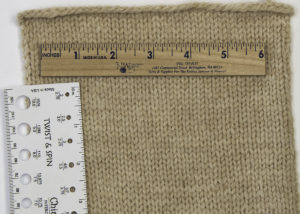

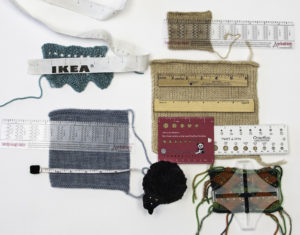

Students Should Bring: If you have any swatches from previous projects, bring them, and whatever measuring devices you have, to class. Also, bring a list of questions that you have, for us to answer in class
Homework: none
Intarsia Motif Design
Class Length: 2 sessions, 2-3 H each, depending on student numbers
Skill: All Levels
Prerequisites: knit, purl, cast on, bind off.
Adding an intarsia motif to a pattern is a special way to personalize a knitted item. Learn how to turn an idea, drawing or photo into a knittable chart. We will discuss size and placement of a motif, and how to create a chart that is fun to knit. Copyright issues and practical tips on how to write the charts will be covered. This class will be heavily discussion-based, and you will be designing, but not actually knitting, in class.


Students Should Bring: Construction paper, or other stiff paper, and Knitters Graph paper. ( (https://www.sweaterscapes.com/land-chart-paper.htm or other on-line site. There are many!) Small scissors suitable for cutting paper, calculator (phone app is fine), pen/pencil. Colored pencils or crayons. A sense of adventure and willingness to accept picking up lots of balled up paper from the floor.
Homework: None
Knitting Beautiful Borders
Class Length: 2 sessions, 2-3 H each, depending on student numbers
Skill: All Levels
Prerequisites: knit and purl
Materials Fee: None
Description: Edgings added to knitted fabric provide stability and decoration. In this class you will learn how to pick up stitches smoothly from any edge of your fabric, what stitch patterns work well for borders, and why. You will learn the i-cord BO, and how to pick up for a reversible edging with no bulky seam, as well as more traditional edging stitch patterns. We will also discuss the factors involved in choosing your edging stitch patterns.
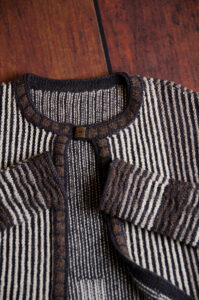


![]()
![]()
Homework: Knit a stockinette swatch, approx 4 in. square, to bring to class. You will be adding edgings to this piece. Knit every stitch, do NOT slip the first stitch of any rows
Students Should Bring: A large knitted swatch of stockinette, at least 4 in. square (your homework). Knitting needles and yarn used for knitting the swatch, and another set of knitting needles 1 or 2 sizes smaller.
Round and Round we go! How to avoid a jog, when striping in the round…
Class Length: 2 sessions, 2-3 H each, depending on student numbers
Skill: All Levels
Prerequisites: Basic knit and purl stitch technique. Cast on, Bind off
Because knitting in the round creates a spiral of rows, changing colors makes a noticeable “Jog” in the fabric. Techniques to minimize this “jog” use slipped stitches in various ways. We aim to create a “jogless jog” when working stripes in circular knitting, one that will not distract the eye. These techniques are tricky to learn, but practicing together in class will give you a good idea on what is the most comfortable choice, for you.
Students Should Bring:
Yarn: 3 or more bright, solid colors, with good contrast to each other. Yarns should have similar fiber content, texture and weight. Suggestion: bring 2 colors that are similar in tone (example: pink and orange), a varigated yarn, and a neutral yarn with lots of contrast (example: black or white). The more colors you have to choose from, the more fun you will have!
Knitting needles: dpn’s, straights and/or circular needles in size appropriate for your yarn. DPN’s will actually be the easiest to use for this class, because it is fastest to knit a small tube (36 sts is what I will recommend) and that is easiest with DPN’s, unless you are whiz with Magic Loop!
Notions: Yarn needles, scissors, locking markers


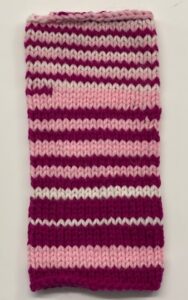


Perfect Edgings: Necklines and Collars
Class Length: 2 sessions, 2-3 H each, depending on student numbers
Skill: All Levels
Prerequisites: Knit, purl
Materials Fee: None
Necklines frame the face, and are a focal point of any sweater. Multiple neckline options from simple to more complex will be discussed:V-neck, boat neck, scoop neck, crew neck, and collared necklines which will give your garments a professional appearance. With your HW swatches, you will choose either a V-neckline or a crew neckline to design and knit on Swatch #1, which will act as the “front”. Swatch #2 will be the “back”, and you will sew to Swatch #1 and knit the collar.
Students Should Bring: Smooth, worsted weight yarn, and circular needles sizes 5, 6, and 7 US. We will be working flat, but you will be creating a curved neckline, so circular needles are recommended. Bring your HW swatches.
Homework: Knit 2 swatches of stockinette at least 6 inches wide and 1 inch deep, knit with the class yarn and size 7 needles. Do not bind off your swatch, bring to class on the needles or holders.
Zipper Insertion into Handknits
Class Length: 2 sessions, 2-3 H each, depending on student numbers
Skill: All Levels
Prerequisites: Knit, purl, bind off, pick up sts, and basic skills using sewing needle and thread
Edgings are an important design element, providing beauty and function. Learn how to pick up and knit stitches into the side of your knitting, to stabilize the edge. We will de-mystify the process of the perfect instillation of zippers into hand-knits.

Students Should Bring: Projects that are ready for edging or zippers are welcome. Bring supplies suitable for those projects. A zipper the length of your project or swatch, extra swatch yarn to use for edgings, and knitting needles 2-3 sizes smaller than used for swatch. Sewing needle, thread which matches the swatch yarn (for sewing zipper) , and sewing thread in a contrasting color (for basting), sewing pins.
Homework: Assemble supplies. If no project is ready, knit and bring to class: 2 swatches at least 3 inches wide, and 4” long, or the same length as the zipper you are bringing to class.
Learn Your Stripes
Class Length: 2 sessions, 2-3 H each, depending on student numbers
Skill: All Levels
Prerequisites: none
Stripes are a versatile way to jazz up our knitting, using one color at a time. We will cover how to choose a stripe sequence, add new yarn efficiently, carry colors up your work, reduce tangles, and cure the “loose edge stitch” problem. We will also play with other stitch patterns than stockinette that work beautifully for striping. This class is going to be the first in a series, exploring stitch patterns that use one color per row to create an amazing variety of textured fabrics.
Students Should Bring: Yarn in at least 2 colors and same weight is recommended. (More colors = more fun) Appropriate knitting needles for the yarn you will be knitting. Your sample will be 4-6 inches wide, so DPN, straight or circular needles will all work well.
Homework: None

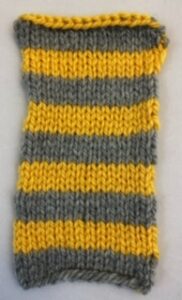
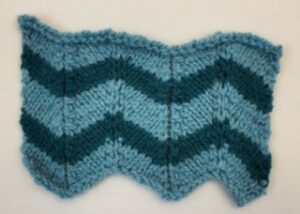
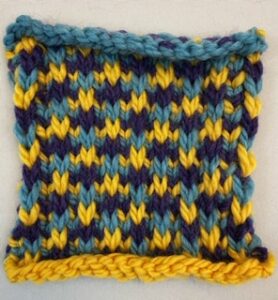
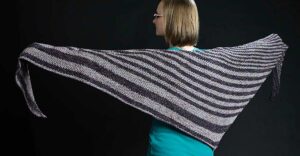

Stranded/Fair Isle Knitting – improve your efficiency
Class Length: 2 sessions, 2-3 H each, depending on student numbers
Skill: All Levels
Prerequisites: Knit, purl
Working with 2 colors on the same row can be slow and confusing. In this class, explore different methods of knitting with 2 yarns at once, to find the best and most comfortable technique for you. There are pros and cons to all of them, which are important to keep in mind. While practicing, we will also explore the meaning of color dominance, how to maintain even tension, and how to prevent yarn tangles.

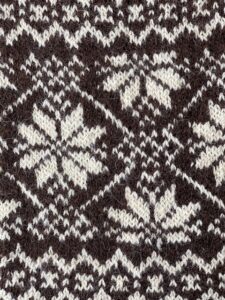
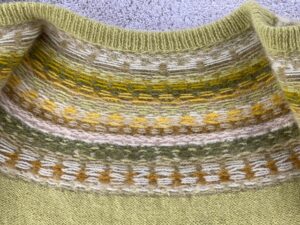



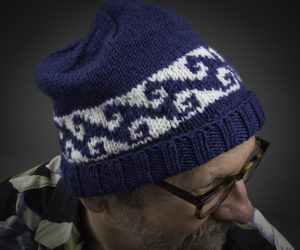
Students Should Bring: Yarn in 2 or more colors, all the same weight, and appropriate needles for working a swatch of 40 sts in the round. DPN’s are recommended, or Magic Loop with a circular needle. If possible, bring both DPN’s and a circular needle to class, so you can practice with both!
Homework: none

